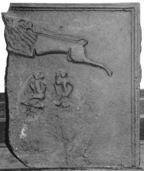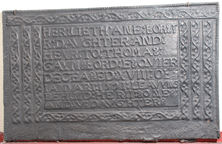-
12
Description: Rectangular; twisted rope edging on top and sides; inscription panel with repeated trailing vine decoration from impressed wooden strips — one horizontal line at top, one vertical strip on right side (missing but probably repeated on left), at least ten short vertical strips below inscription.
Notes: Formerly at Fulling Mill Cottages, and possibly formerly at Wakehurst Place, Ardingly; it was moved to Ardingly church sometime after 1915. The inscription panel is identical to that on the memorial plate to Anne Forster in Crowhurst church, Surrey; at least ten other firebacks are known with the same inscription panel. Edward Culpeper (1561-1630), of Wakehurst, was fourth cousin, once removed, of Anne Forster. Assuming the vine strip and rope edging on the left side were of approximately the same width as on the right the overall original width of the fireback is estimated to have been 837mm.
Inscription: HER : LIETH : ANE : FORST/ R : DAVGHTER : AND : / HEYR : TO : THOMAS : / GAYNSFORD : ESQVIER / DECEASED : XVIII : OF: / IANVARI : 1591 : LEAVYNG / BEHIND : HER II : SONES : / AND : V : DAVGHTERS
- Decoration tags:
- rectangular (shape)
- rope (edging)
- carved stamps
- carved pattern panels
- planklines
- text
- plants
Manufactured: in the late-16th century possibly at Pounsley Furnace, Framfield in the Weald area of England.
Current location: St Peter's Church, Church Lane, Ardingly, West Sussex, England.
Citation: Holgate, M. S., n.d., The Parish Church of St Peter, Ardingly: Historical and Architectural Notes.
-
349
Description: Arched rectangular shape; ovolo-moulded edging; Tudor royal shield, garter, crown, motto and supporters (crowned lion and dragon); Tudor rose to right of lion’s head, portcullis to left of dragon’s head; temp. Elizabeth I.
Notes: Three versions of this fireback are known, with differing edging and one without the rose and portcullis.
Copies of this fireback are known.
Inscription: [Garter] HONI SOIT QVI MAL Y PENSE / [motto] DIEV ET MON DROIT.
Arms: Tudor royal
- Decoration tags:
- rectangular with round arch (shape)
- ovolo (edging)
- whole carved pattern
- heraldic
- armorial
- royal
- text
Manufactured: in the late-16th century possibly in the Weald area of England.
Current location: Bramshill House, Bramshill, Hampshire, England.
Citation: Baines, J. M., 1958, Wealden Firebacks (Hastings Museum).
- Attached to series:
- Tudor royal armorial firebacks
-
31
Description: Fragment; rectangular plate with series of parallelogrammatic billets arranged across the top; crossed billets in corners
- Decoration tags:
- rectangular (shape)
- none (edging)
- simple stamps
Manufactured: possibly in the Weald area of England.
Current location: in private hands Burwash, East Sussex, England.
- Attached to series:
- Miscellaneous stamp firebacks
-
319
Description: Arched rectangular shape; cyma-reversa edging; Tudor royal shield, garter, crown, motto and supporters (crowned lion and dragon); Tudor rose to right of lion’s head, portcullis to left of dragon’s head; temp. Elizabeth I.
Notes: This a replica cast from a modern pattern by Thomas Elsley Ltd. of London in imitation of a Tudor original.
Copies of this fireback are known.
Inscription: [Garter] HONI SOIT QVI MAL Y PENSE / [motto] DIEV ET MON DROIT.
Arms: Tudor royal - Elizabeth I
- Decoration tags:
- rectangular with round arch (shape)
- cyma reversa/ogee (edging)
- whole carved pattern
- armorial
- royal
- text
Manufactured: in the late-19th to early-20th century at Portland Metal Works, Great Titchfield Street in the London area of England.
Current location: not known.
- Attached to series:
- Tudor royal armorial firebacks
-
261
Description: Plain rectangular bottom panel with fillet on top; above, rectangular panel with fillet and ovolo-moulded edging, within which the initials, ER, ornately carved, intertwined with floral tendrils; on each side, a scrolled bracket with double fillet edging, enclosing [?] ears of corn; on top, a narrow cornich, with an arch above, scrolled at each end and with double fillet edging, enclosing the date, possibly formed of individual stamped letters.
Notes: The 'ER' initials should not be assumed to be those of Elizabeth I. Formerly at Ockwells Manor, Cox Green, Berkshire. Christie's auction 4 Nov 2008 lot 259 (£3,750).
Copies of this fireback are known.
Inscription: 1565 / ER
- Decoration tags:
- rectangular with round arch (shape)
- complex individual (edging)
- whole carved pattern
- individual numbers
- text
- plants
Manufactured: in 1565 in the Weald area of England.
Current location: not known.
- Attached to series:
- Personal firebacks
- Date & initials firebacks
-
1007
Description: Rectangular; twisted rope edging on top and sides; cavetto-moulded-edged rectangle top centre, enclosing date between initials; 14 shields of Ayloffe impaling Sulyard arranged 5-4-5; Ayloffe: sable, a lion rampant Or, collared gules, between three crosses formy of the second; Sulyard: argent, a chevron gules between three pheons inverted sable.
Notes: William Ayloffe (c1535-1584) of Bretons, Hornchurch, Essex, Justice of the Court of Queen's Bench, married (c1560) Jane, dau. of Sir Eustace Sulyard, of Runwell, Essex. A large number of variants use the same shields; this example, unusually, has the initials RS instead of the more common CT. Illustration from Cowper (1911). Previously at Loddenden, Staplehurst, and before that at Great Cheveney, Marden, Kent.
Inscription: R 1627 S
Arms: Ayloffe impaling Sulyard (William Ayloffe of Bretons, Hornchurch)
- Decoration tags:
- rectangular (shape)
- rope (edging)
- carved stamps
- individual letters
- individual numbers
- armorial
- text
Manufactured: in 1627 possibly at Hawkhurst Furnace in the Weald area of England.
Current location: not known.
- Attached to series:
- Ayloffe series
- Personal armorial firebacks
-
280
Description: Arched rectangular shaped central panel, bead edging (top and sides), pedestal bearing a supine male figure with headband being trampled by a horse, facing left, mounted by a rider with long hair, facing to the front; on each side of the plinth is a seated figure wearing a hat, with a basket of fruit; above the rider are crescent lines representative of clouds; the inscription is split either side of the horse; the date (‘7’ rotated and, with ‘4’, reversed) is on the die of the pedestal; arched rectangular shaped border, fillet edging, on each side a Solomonic column with vine decoration; in the arch, symmetrical parallel curved lines with a central oval cartouche beneath a crown; on top of each shoulder of the plate a figure in repose.
Notes: The equestrian figure is derived from the statue of Charles II erected in Stocks Market, London, in 1672. Originally to be of Jan Sobieski, later king of Poland, riding down a Tatar, it was altered to represent Charles, and the Tatar’s face was changed to that of Oliver Cromwell; the statue attracted a fair degree of derision. The statue is now at Newby Hall, near Ripon, North Yorkshire. Another version (no. 464), probably by the same pattern-maker, omits a date and has altered initials.
Copies of this fireback are known.
Inscription: C R / 1674
- Decoration tags:
- 'Dutch' (shape)
- cavetto (edging)
- whole carved pattern
- individual numbers
- pictorial
- historical
- architectural
- text
- animals
- humans
Manufactured: in 1674 in England.
Current location: Chequers, Ellesborough, Buckinghamshire, England.
Citation: Lloyd, N., 1925, 'Domestic Ironwork I', Architectural Review, 58, pp. 58-67.
- Attached to series:
- Carolean 'Dutch' series
- Commemorative firebacks
-
1006
Description: Rectangular shape with twisted rope edging (top and sides); date split between top corners.
Notes: The central button on the number 1 is consistent with a date in the first half of the seventeenth century. Hall's auction, Shrewsbury, 28 Oct 2015, lot 127 (£190).
Inscription: 16 37
- Decoration tags:
- rectangular (shape)
- rope (edging)
- individual numbers
- text
Manufactured: in 1637 possibly in the Shropshire area of England.
Current location: in private hands, Wigmore, Herefordshire, England.
- Attached to series:
- Date only firebacks
-
126
Description: Fragment; rectangular; astragal and fillet edging (top and sides); oblique lion passant above two left facing 'imps', one with right arm raised, the other with both arms lowered.
Notes: One of the legs of the leopard is missing, suggesting that the stamp, which appears complete on many firebacks, was well used and had been damaged; this suggests a relatively late use of this stamp.One of a large series all bearing royal heraldic stamps, but unusual in the use of moulded edging, twisted rope being normally used for this series. The surviving elements were probably mirrored on the missing half. Formerly part of the Ade Collection (from Grove Hill, Hellingly, Sussex).
- Decoration tags:
- rectangular (shape)
- astragal & fillet (edging)
- carved stamps
- heraldic
- animals
- humans
Manufactured: in the mid- to late-16th century in the Weald area of England.
Current location: Hastings Museum and Art Gallery, John's Place, Bohemia Road, Hastings, East Sussex, England.
Museum number: HASMG: 1952.51.12 (LA 760) (part of the Hastings Museum museum group)
- Attached to series:
- Royal series
-
369
Description: Quasi-rectangular shape; rope edging on top and sides; central inscription panel; repeated trailing vine decoration from impressed wooden strips — one horizontal line at top, three vertical strips at each side, one horizontal strip below panel, plain panel at base.
Notes: A series of firebacks all bearing the inscription carved onto a panel and included with other stamps in the casting of the iron graveslab covering the tomb of Anne Forster (Foster) in St George’s church, Crowhurst, Surrey. Formerly in the John H. Every Collection, for which it was purchased in 1921 at Isfield Place, Sussex.
Inscription: HER : LIETH : ANE : FORST/ R : DAVGHTER : AND : / HEYR : TO : THOMAS : / GAYNSFORD : ESQVIER / DECEASED : XVIII : OF: / IANVARI : 1591 : LEAVYNG / BEHIND : HER II : SONES : / AND : V : DAVGHTERS
- Decoration tags:
- rectangular (shape)
- rope (edging)
- simple stamps
- carved stamps
- planklines
- text
- objects
Manufactured: in the late-16th century possibly at Pounsley Furnace, Framfield in the Weald area of England.
Current location: Anne of Cleves House, Southover High Street, Lewes, East Sussex, England.
Museum number: 1944.24.043 (part of the Sussex Archaeological Society museum group)
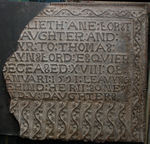
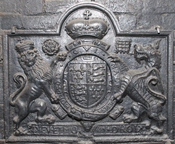
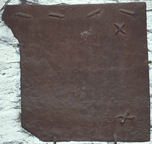
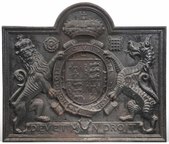
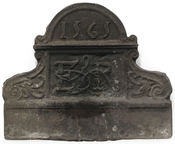
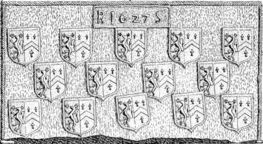
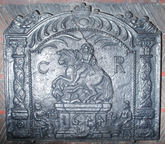
,_lot_127_28_oct_2015a.jpg)
